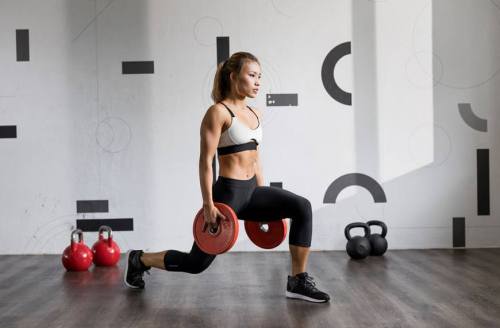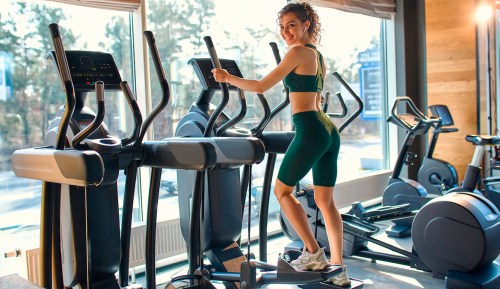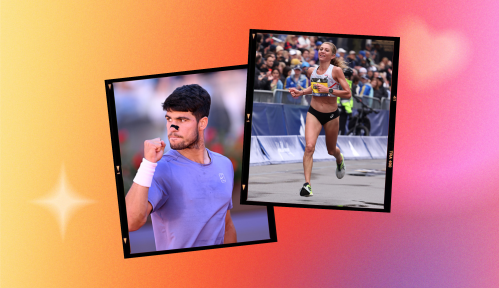5 do-it-all exercise moves that work your entire body at once
An Equinox trainer provides five key moves that work your entire body to save time at the gym.

Going to workout can be an overwhelming (albeit endorphin-boosting!) experience. When I walk into a gym, for instance, I’m greeted by the vast landscape filled with machines specifically designed to work different areas of the body. Tally up all your limbs and muscle groups, and you’re looking at quite a time-consuming task of working it all (I mean, there are four muscles in your upper arm alone).
That’s why I live for workout moves that do it all—I’m talking full-body sequences that do more than flex a sole muscle at a time. “There are a lot of benefits of doing compound movements such as working more than one muscle at a time,” says Andrea Somer, tier 3 trainer at Equinox in West Hollywood. “Compound movements improve how all the muscles in the body work together to produce and control force and stability. They also involve more muscle tissue and require more oxygen, which ultimately allows you to burn more calories.” So that means burning more calories in less time—a win-win.
“They involve more muscle tissue and require more oxygen, which ultimately allows you to burn more calories.” —Andrea Somer, Equinox trainer
These movements aren’t just for strength training, either—they’re complex and get your whole body working hard enough that they count as cardio, too (see ya, treadmill). “You’ll get your heart rate up since these exercises require the heart to pump more blood to keep the muscles fueled and active,” Somer explains.
As for the icing on the sweaty top? “Compound exercises improve your movement skills in all planes of motion that you’ll need in your everyday life,” she says. Boom: work-life-balance in a nutshell.
Consider it more burn for your buck (and enjoy all that extra time you’ve saved). Keep scrolling for the 5 killer moves.

Dumbbell thrusters
These are essentially a squat-to-shoulder press. “Stand with feet shoulder-width apart and hold one dumbbell in each hand so the dumbbells are in front of each shoulder with the palms facing each other,” says Somer. “Sink into the hips to perform a squat. At the bottom, press both feet into the ground to move to a standing position. Press both arms overhead while keeping the palms facing each other. Coordinate the moves so that the weight is lowered while sinking into the squat and the weights are pressed overhead once a standing position is reached.”
Renegade rows
“Start in a push-up position with the hands holding onto dumbbells that are lined up parallel to each other,” Somer explains. “Perform a push-up. At the top of the push-up, press both feet into the ground to create stability while pulling the right dumbbell up to the chest in a rowing move—the elbow brushes against the rib cage. Place the right hand down and perform a rowing move with the left hand. Once a row has been completed on each side, perform another push-up.”
Reverse lunge to balance with shoulder press
“Stand with feet hip-width apart while holding one dumbbell in one hand hanging next to the body with your palm facing the body,” says Somer. “Step backward with the right foot and lower the hips. Push the left foot into the ground and bring the right foot forward to return to standing. At the top, stay balanced on the left leg—don’t let the right foot touch the ground—and perform a shoulder press with your right arm. Complete one leg before switching to the other leg.”
Walking lunges with bicep curls
“Take a dumbbell in each hand and hold them at your waist,” says Somer. “Step forward with your right foot and bend at the knee so that your back knee almost touches the ground. As you’re down in the lunge motion curl the dumbbells upward with your bicep muscle. Bring the back left leg forward and stand up. Now step out with the left leg repeating the steps. Repeat the walking lunge motion for the desired amount of repetitions.”
Side lunge to chest press
“Assume an athletic standing position, with the knees and hips slightly bent, feet shoulder-width apart, and the head and chest up, holding a dumbbell with both hands in front of your chest with elbows resting on your sides,” says Somer. “Staying low, take a slow, lateral step to the right. Keep your toes pointed forward and remain low. Extend the left knee, driving your weight to the right, flexing the knee and hip into a side lunge. Maintain good posture through the entire spine, keeping your head and chest up. Pause at the bottom of the motion, and then extend through the working leg to return to a standing position while extending your arms pressing the dumbbell straight out, transitioning into a lunge to the opposite side.”
Once that’s finished, here’s a stretching routine for mobility, and some hip-flexor stretches to combat tightness.










